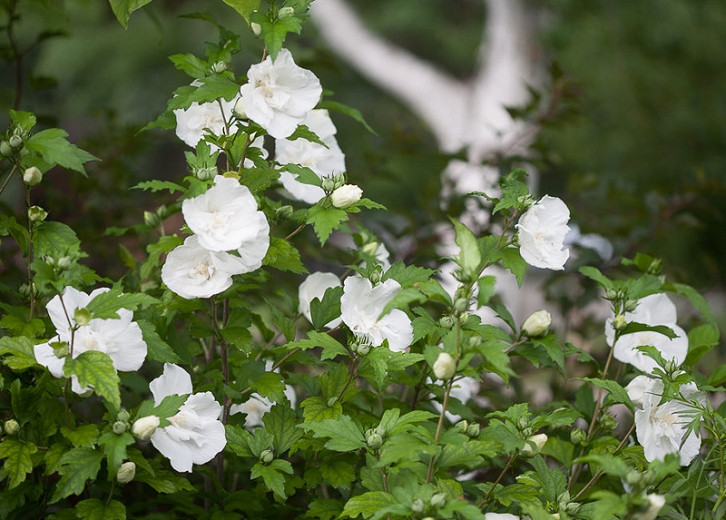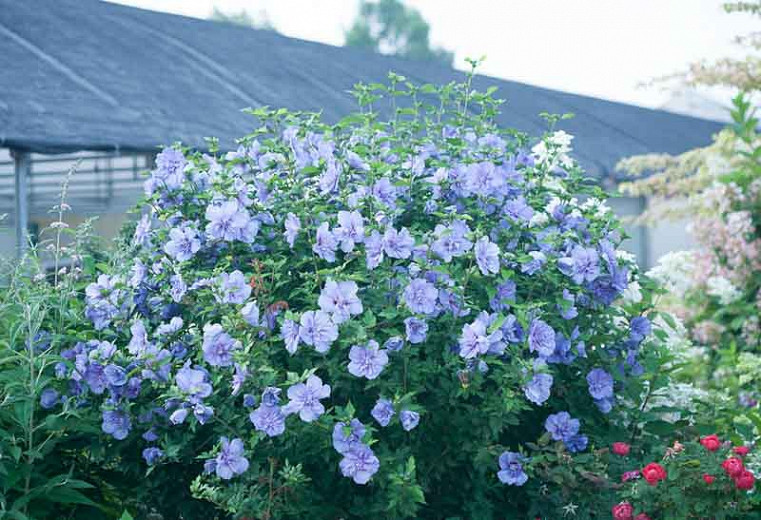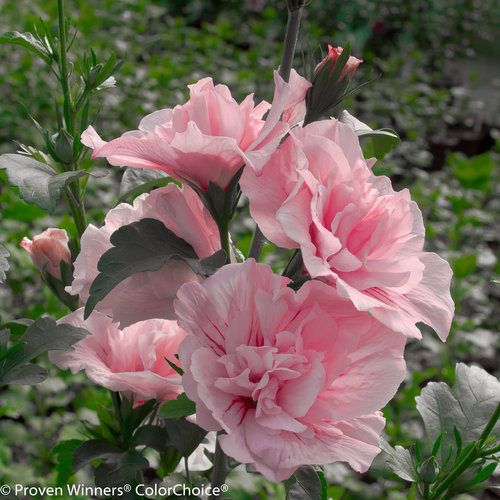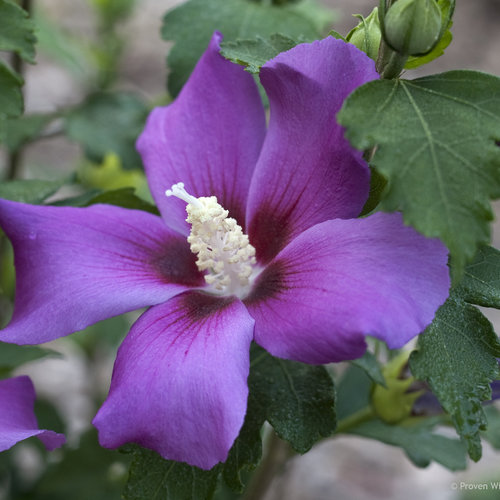The Hibiscus Syriacus: A Flower That Symbolizes Eternity
The hibiscus syriacus, also known as the rose of Sharon or althea, is a beautiful flowering shrub that is native to Asia. It is known for its large, showy flowers that come in a variety of colors, including white, pink, purple, and blue. The hibiscus syriacus is a popular ornamental plant that is grown in gardens all over the world.
In addition to its beauty, the hibiscus syriacus also has a rich symbolism. In many cultures, the hibiscus syriacus is a symbol of eternity. This is because the plant blooms for a long time, often from early summer to late fall. The hibiscus syriacus is also a symbol of inexhaustible abundance. This is because the plant produces a large number of flowers, which can be used for a variety of purposes, such as making tea, dye, and medicine.
The hibiscus syriacus has a long history of use in traditional medicine. In Chinese medicine, the hibiscus syriacus is used to treat a variety of ailments, including sore throat, fever, and cough. The hibiscus syriacus is also used in traditional Korean medicine to treat a variety of conditions, such as high blood pressure, diabetes, and cancer.
The hibiscus syriacus is a versatile plant that can be used for a variety of purposes. It is a beautiful ornamental plant that can add color and beauty to any garden. The hibiscus syriacus is also a valuable medicinal plant that can be used to treat a variety of ailments.
Main Content
- History and Origin
The hibiscus syriacus is native to Asia, where it has been cultivated for centuries. The plant was introduced to Europe in the 16th century, and it quickly became popular as an ornamental plant. The hibiscus syriacus was introduced to North America in the 17th century, and it is now a common sight in gardens throughout the continent.
- Botanical Description
The hibiscus syriacus is a deciduous shrub or small tree that can grow up to 15 feet tall. The plant has large, showy flowers that can reach up to 6 inches in diameter. The flowers come in a variety of colors, including white, pink, purple, and blue. The hibiscus syriacus blooms from early summer to late fall.
- Growing Conditions
The hibiscus syriacus is a relatively easy plant to grow. The plant prefers full sun and well-drained soil. The hibiscus syriacus is drought-tolerant, but it will do best with regular watering. The plant is hardy in USDA zones 5-9.
- Pests and Diseases
The hibiscus syriacus is susceptible to a few pests and diseases, including aphids, spider mites, and powdery mildew. These pests and diseases can be controlled with insecticidal soap or neem oil.
- Propagation
The hibiscus syriacus can be propagated by seed, cuttings, or division. Seed propagation is the most difficult method, but it can be successful if the seeds are fresh. Cutting propagation is the most common method, and it is relatively easy to do. Division is another easy way to propagate the hibiscus syriacus.
- Uses
The hibiscus syriacus is a versatile plant that can be used for a variety of purposes. The plant is a beautiful ornamental plant that can add color and beauty to any garden. The hibiscus syriacus is also a valuable medicinal plant that can be used to treat a variety of ailments.
- Symbolism
The hibiscus syriacus has a rich symbolism in many cultures. In many cultures, the hibiscus syriacus is a symbol of eternity. This is because the plant blooms for a long time, often from early summer to late fall. The hibiscus syriacus is also a symbol of inexhaustible abundance. This is because the plant produces a large number of flowers, which can be used for a variety of purposes, such as making tea, dye, and medicine.
Conclusion
The hibiscus syriacus is a beautiful and versatile plant that has a rich history and symbolism. The plant is a popular ornamental shrub that can be grown in gardens all over the world. The hibiscus syriacus is also a valuable medicinal plant that can be used to treat a variety of ailments.
Hibiscus syriacus, also known as rose of Sharon, is a beautiful and versatile shrub that can add a touch of color to any garden. With its large, showy flowers that come in a wide range of colors, hibiscus syriacus is sure to turn heads.
If you're thinking about adding a hibiscus syriacus to your garden, Garden Wiki is a great resource for more information. The website has a wealth of information about hibiscus syriacus, including its care requirements, different varieties, and how to identify your plant.
In addition to providing information about hibiscus syriacus, Garden Wiki also offers a variety of other resources for gardeners, including plant care tips, gardening articles, and a blog. Whether you're a beginner or a seasoned gardener, Garden Wiki is a great resource for all things gardening.
FAQ of hibiscus syriacus
- What is hibiscus syriacus?
Hibiscus syriacus, also known as Rose of Sharon, is a hardy shrub that is native to Asia and Europe. It is known for its large, showy flowers that come in a variety of colors, including white, pink, purple, and blue. Hibiscus syriacus is a popular ornamental plant that can be grown in USDA hardiness zones 3-9.
- How do I grow hibiscus syriacus?
Hibiscus syriacus is relatively easy to grow. It prefers full sun and moist, well-drained soil. It is important to water hibiscus syriacus regularly, especially during hot, dry weather. Fertilize hibiscus syriacus every few months during the growing season. Hibiscus syriacus can be pruned in late winter or early spring to shape the plant and encourage new growth.
- What are some common problems with hibiscus syriacus?
Hibiscus syriacus is susceptible to a few common problems, including:
- Leaf spot: This fungal disease causes brown or black spots on the leaves. To treat leaf spot, remove infected leaves and apply a fungicide.
- Aphids: These small insects can suck the sap from hibiscus syriacus leaves, causing them to wilt and curl. To control aphids, spray the plant with insecticidal soap or neem oil.
- Scale: These small, sap-sucking insects can also damage hibiscus syriacus. To control scale, scrape off the insects with a knife or insecticidal soap.
- How can I propagate hibiscus syriacus?
Hibiscus syriacus can be propagated by seed, cuttings, or division. Seed propagation is the most common method. To propagate hibiscus syriacus from seed, sow the seeds in a well-drained potting mix in the spring. Keep the potting mix moist and warm until the seeds germinate.
Hibiscus syriacus can also be propagated from cuttings. To propagate hibiscus syriacus from cuttings, take 4-6 inch cuttings from healthy, non-flowering stems in the spring or summer. Remove the lower leaves from the cuttings and dip them in rooting hormone. Plant the cuttings in a well-drained potting mix and keep them moist. The cuttings should root in 4-6 weeks.
Hibiscus syriacus can also be propagated by division. To propagate hibiscus syriacus by division, dig up a mature plant in the spring or fall. Use a sharp knife or spade to divide the plant into several sections. Each section should have at least 3-4 roots. Plant the divisions in well-drained soil and water them well.
- What are the health benefits of hibiscus syriacus?
The flowers of hibiscus syriacus have been used in traditional Chinese medicine for centuries to treat a variety of health conditions, including:
- High blood pressure: Hibiscus syriacus tea has been shown to lower blood pressure in people with hypertension.
- High cholesterol: Hibiscus syriacus extract has been shown to reduce LDL (bad) cholesterol and increase HDL (good) cholesterol.
- Diarrhea: Hibiscus syriacus tea can help to reduce diarrhea by binding to toxins and bacteria in the gut.
- Vaginal discharge: Hibiscus syriacus tea can help to reduce vaginal discharge by killing harmful bacteria.
- Hemorrhoids: Hibiscus syriacus tea can help to reduce hemorrhoids by reducing inflammation and pain.
Image of hibiscus syriacus
5 different images of "hibiscus syriacus" from Pinterest:
- White hibiscus syriacus: This hibiscus has large, white flowers with a slightly pink center.

- Blue hibiscus syriacus: This hibiscus has deep blue flowers with a white center.

- Pink hibiscus syriacus: This hibiscus has bright pink flowers with a yellow center.

- Purple hibiscus syriacus: This hibiscus has deep purple flowers with a white center.

- Red hibiscus syriacus: This hibiscus has bright red flowers with a yellow center.

Post a Comment for "The Hibiscus Syriacus: A Flower That Symbolizes Eternity"